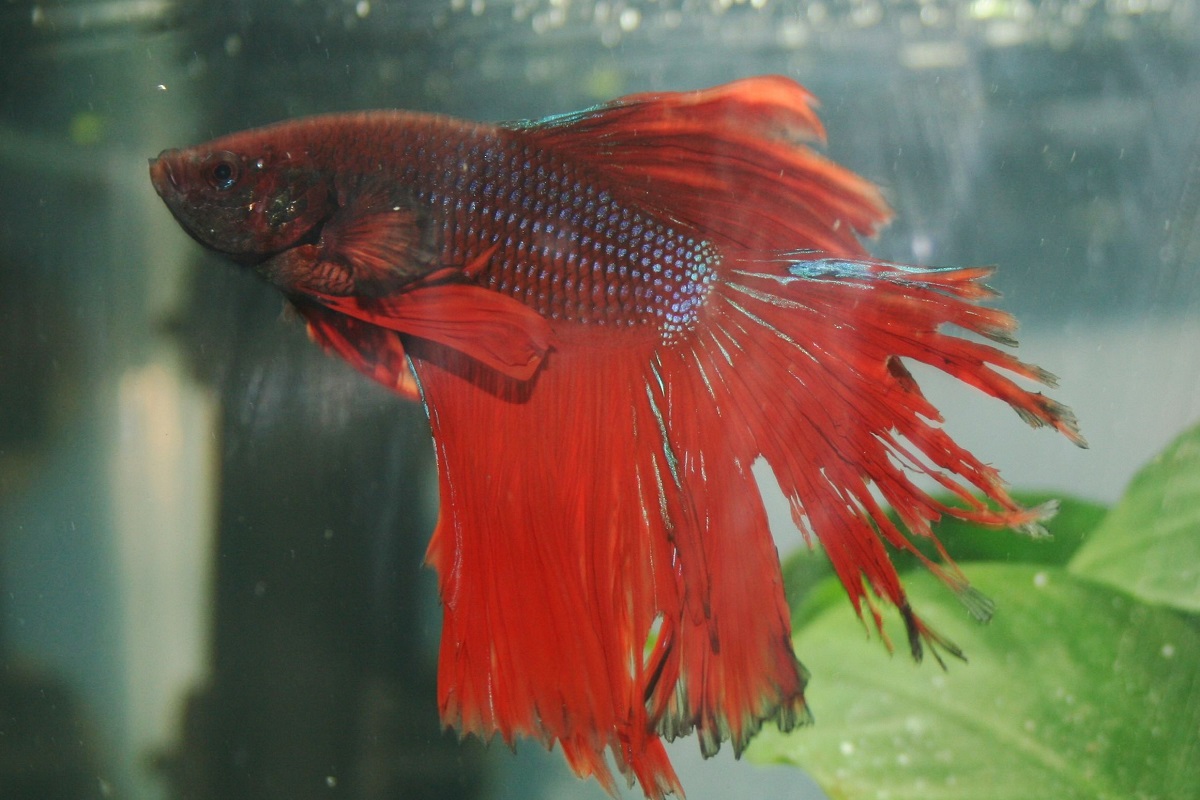Betta fish, originally from the tranquil shallow waters of Asia’s ponds, streams, and marshes, offer a captivating experience for aquarists and pet enthusiasts alike. Renowned for their dynamic personalities and striking appearance, these fish bring a lively burst of color to any aquatic setting.
With an impressive diversity of over 70 types, betta fish dazzle with a variety of vivid colors, intricate patterns, and elegant tail designs. Their low-maintenance nature makes them an appealing choice for both novice and experienced fish keepers, enriching the aquarium experience with minimal fuss.
However, it’s important to note that these colorful companions can be prone to health issues, with fin rot being a prevalent concern. This condition not only affects their stunning appearance but can also lead to more serious health problems if not addressed.
In the following sections, we’ll dive into the causes and symptoms of fin rot, providing you with valuable insights into treatment options and preventive measures. By understanding how to care for your betta fish properly, you can ensure they remain vibrant and healthy, adding joy and beauty to your home aquarium.
Contents
What Is Fin Rot?
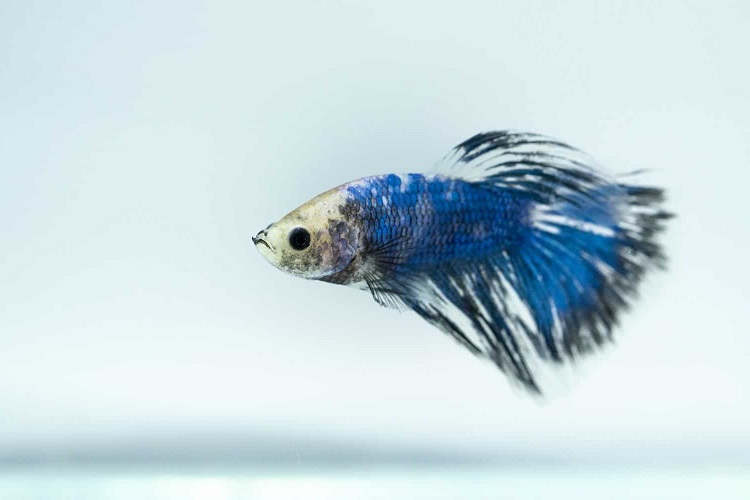
Fin rot is a common disease suffered by many betta fish living within an aquarium. Most often caused by bacteria in the fish tank, fin rot is a serious yet treatable disease among betta fish.
Often triggered by stress or unclean environments, fin rot weakens the immune system of your betta fish, causing them to become ill. Your bettas are more prone to developing fin rot if your aquarium is in poor condition, overcrowded, or contains aggressive fish.
Fin rot attacks the tail and fins of healthy fish, causing life-threatening conditions to the health of your betta fish.
Thankfully, through the help of proper treatment and maintenance of your aquarium, your bettas can recover from this terrible disease.
Symptoms of Betta Fin Rot
Every fish owner hopes to have healthy, vibrant fish. But catching betta fin rot can be challenging for new fish owners. In this section, we examine the symptoms of betta fin rot.
Warning signs of betta fin become overlooked because they are so minute. In the beginning development stages of betta fin rot, the edges of your betas fins will become discolored with a milky color.
It’s not until the tail or fins begin to shed that the disease becomes apparent. Betta fin rot progresses rapidly, and the infection spreads, causing the betta’s fins and tail to become discolored as pieces fall off or become covered in white cloud-covered spots.
Keeping your aquarium clean and monitoring your betta fish for sudden traces of fin rot is crucial for the overall health of your betta fish. Other symptoms of betta fin rod include:
- Brown, black, white, or cream-colored spots
- Developing frayed or ragged edges
- Pieces of the betta fish tail or fins falling off
- Lack of energy or lethargy
- Betta fish showing a lack of appetite
- Vibrant colors fading
You may also notice enlarged skin around your fish’s fins or tail areas. One way to spot lethargy is to pay attention to whether your fish is swimming around or is hanging around the bottom of the tank more than usual.
Betta fin rot is contagious to other tank mates. Therefore if you notice any symptoms in your bettas, it’s critical to separate them from other tank mates and take immediate steps to treat the disease.
Causes of Betta Fin Rot

Thankfully, it’s not the end of the world if you notice that your betta fish has fin rot. Betta fin rot is one of the most frequent diseases among bettas.
Fin rot is treatable by improving your fish’s immune system. This treatment will also help to prevent further outbreaks of this disease from infecting your tank again in the future.
There are several causes of betta fin rot. The most common cause of betta fin rot is bacteria growing in your fish tank. Some reasons that bacteria may grow in your betta fish tank may include:
- Poor water quality in the fish tank
- Having a poor filtration system in your aquarium
- Overcrowding your fish tank
Harmful levels of ammonia in your aquarium can also cause bacteria to grow. If you use tap water to fill your tank, keep an eye out for high amounts of chloramine and chlorine. You can find testing kits at your local pet store if you’re unsure about these levels.
You also need to ensure you’re not overfeeding your fish, as excess food can pollute the tank. Using a powerful filtration system helps to keep bacteria levels down in your aquarium. It’s also vital to maintain a water temperature below 78 degrees and keep your aquarium regularly cleaned, so it’s free from leftover foods and fish fecal matter.
Although bacteria in your fish tank is the leading cause of betta fin rot, there are several other causes. Fin rot can be caused by stress, poor feeding schedules, environmental changes, and inadequate tank cleaning. Your fishes may get stressed if they have aggressive tank mates or they’ve recently been moved to a new environment.
Prevention of Betta Fin Rot
The most effective prevention of betta fin rot is keeping your aquarium well filtered and regularly cleaned to decrease unwanted bacteria from building up in your tank. Keeping your tank clean not only looks more appealing but also helps to keep your betta fish happy and healthy.
Here are a few ways to ensure your tank is cleaned:
- Changing the water in your fish tank weekly
- Testing the water chemistry and pH balance of your aquarium
- Testing your water for unwanted chlorine levels
- Avoiding over-feeding if you notice extra debris floating
- Investing in a larger aquarium to prevent overpopulation
- Separating aggressive betta fish
- Watching for early signs of betta fin rot
- Watching for changes in your betta’s daily behavior
Treatment of Betta Fin Rot
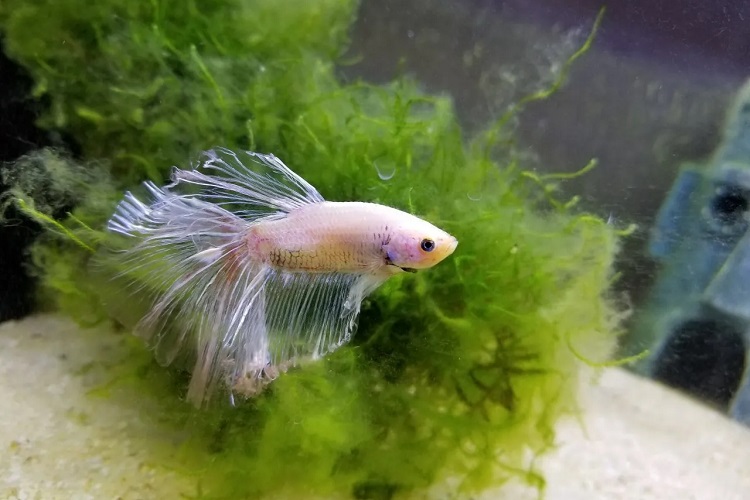
Betta fin rot is most commonly seen in dirty fish tanks or when a fish becomes injured by an aggressive fish in the tank.
The best way to treat betta fin rot is to be vigilant about your tank’s maintenance and keep a close eye on your betta’s daily behavior. If you notice an aggressive bully in your tank, separate them before injury occurs.
If detected early enough, fin rot is easily treated with medication from your local pet store. A betta fish with a healthy aquarium is at a lesser risk of contracting betta fin rot.
However, even after keeping a clean tank and separating bullies, there’s still a chance that your betta fish may develop fin rot. If so, here are some steps to help treat your betta fish and maintain a healthy lifestyle.
1. Changing Your Water
Removing 25% of your water from your fish tank and replacing it with clean water is a critical step in betta fin rot treatment. Maintaining clean water in your fish tank at all times is the first step to treating betta fin rot and preventing it from occurring again.
Sometimes all it takes is keeping a clean tank to help treat mild betta fin rot. If symptoms continue to persist, there are several other treatments to try.
2. Cleaning the Gravel in Your Tank
Removing the gravel from the bottom of your aquarium and rinsing the debris off it is also critical in treating betta fin rot.
Sometimes debris becomes lodged in the gravel and leads to bacteria within your aquarium. It’s beneficial to clean your gravel, plants, and other decorations to prevent bacteria from forming inside your tank.
3. Cleaning Your Filter
The filter is another essential part of the fish tank to keep clean. Remove your filter and run it under water to remove trapped particles and bacteria.
A clean filter will help maintain the overall cleanliness of your tank. You must clean your filter every time you clean your tank to ensure your fish stay in a healthy environment.
4. Testing Your pH Levels
Testing your aquarium water levels regularly to ensure proper pH balance within your fish tank is crucial for treating betta fin rot. You can buy from your local pet store or vet for a reasonable price. The small cost is worth it to maintain a healthy betta fish tank.
5. Quarantining Infected Fish
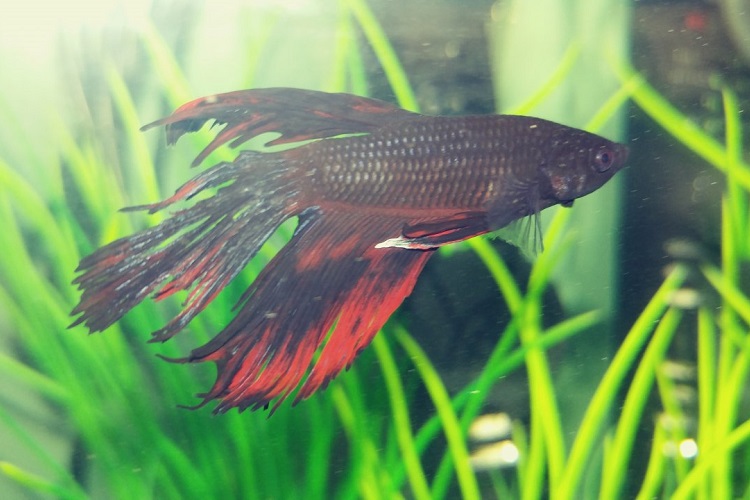
Transferring affected betta fish to a new holding tank is essential to preventing the disease from spreading to otherwise healthy betta fish. After the fish has received treatment, and their symptoms have regressed, you can return them to their tank mates.
6. Removing Bullies From the Tank
Separating bullies is another critical factor to consider when treating betta fin rot. Aggressive bullies can cause injuries to other betta fish, which leads to fin rot.
By removing the bullies from the tank, you can help prevent the chances of other bettas developing fin rot, or cases progressing in affected bettas. You also ensure that your fish aren’t stressed, improving overall health.
7. Removing Carbon From Filter
Another treatment measure in curing betta fin rot is to remove the carbon from your tank’s filter. Carbon is intended to remove chemicals from your fish tank. Leaving carbon in your filter will remove any medication you want to treat your fish with.
8. Medicating Your Betta Fish
Thankfully, betta fin rot is treatable with medications that can be purchased over the counter at your local pet store for under $30.00. One common product used to treat fin rot is Melafix Bacterial Remedy. This product treats the betta fin rot and sanitizes the tank water to prevent the disease from returning.
The second medication used in the treatment of betta fin rot is aquarium salt. Although this remedy takes longer to take effect, it’s still a popular treatment choice. You should stop using aquarium salt after ten days to prevent other medical problems such as liver or kidney damage.
Other products on the market for betta fin rot include Bettafix or Melafix. These are cost-effective and can be used for certain types of bettas. It’s best to speak to a knowledgeable person who works in the pet store to direct you in making the best purchase for your particular type of betta fish.
9. Administer the Recommended Dosage of Treatment
Sometimes when treating your betta fish with medications for fin rot, their symptoms may begin to disappear quickly. But, just because the fish looks better, never stop their treatment early. Finish the entire treatment before re-introducing the fish to its old tank mates again.
10. Try Not To Disturb Your Recovering Betta
When a betta fish is recovering from fin rot, try not to disturb them when changing their water and feeding them. Their bodies are very delicate, to begin with, and even more so when they’re sick.
Your betta’s best chance for survival and being cured of fin rot is living a stress-free life during treatment.
How You Can Tell If Betta Fin Rot Has Been Cured
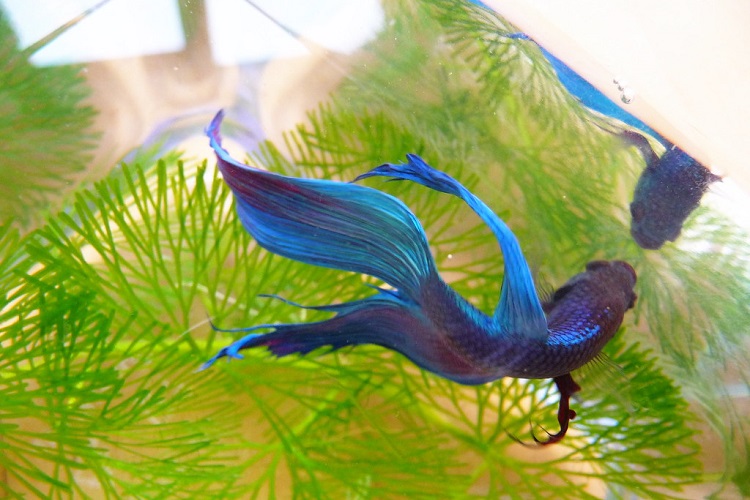
Sometimes if your betta is suffering from mild fin rot, all it takes is separating your fish and placing it in a clean fish tank to stop the progression of the disease.
If your fish disease is more severe, and you’re treating it with medication, here are some signs to look for to indicate that your betta fish is recovering well:
- The discoloration and spots haven’t spread
- Your fish hasn’t developed new symptoms
- Your fish is swimming around the tank again
- The betta fish has regained its appetite
Your betta fish’s fin may also start to regrow. This regrowth may alter your fish’s appearance as it may be in a new color.
Betta Fin Rot Prevention
After your betta fish is feeling better, there are several measures to decrease the chances of fin rot returning. Here’s a list of recommendations to consider:
1. Maintain a Clean Fish Tank

Continue to maintain a clean fish tank even after your fish is feeling better. To help remind you to clean your tank, keep a maintenance calendar on your wall. Another alternative is to set a weekly alert on your phone.
2. Don’t Overcrowd Your Betta Fish
Never keep too many fish in one tank because it can create more bacteria with a higher amount of feces in the water. It may also lead to bullying and fighting for food, causing injury to your bettas.
3. Don’t Overfeed Your Bettas
Only feed your fish small amounts of food to prevent polluting your tank. After all, they’re very small and don’t need much food for survival. Overfeeding your fish causes unwanted bacteria in your tank.
4. Monitor Lighting in Your Aquarium
Bettas naturally live in dark areas. So, they don’t require a lot of light. Bright lights stress your betta fish and can cause fin rot to return. Placing your aquarium in natural lighting is best for healthy betta fish.
5. Separate Bullies From the Tank
Removing aggressive tank mates is essential to avoid injury to your betta fish and prevent fin rot from reoccurring. Bullies also cause stress to other betas, which can lead to fin rot.
6. Keep Your Tank at the Right Temperature

Even after your betta has recovered from fin rot, it’s important to keep their aquarium at a suitable temperature to prevent fin rot from reoccurring. A healthy aquarium should be around 78 degrees Fahrenheit to prevent unhealthy bacteria from forming in the tank.
7. Pay Attention to the Signs
Visually examine your betta fish every time you feed them to ensure that fin rot hasn’t reoccured. With early treatment, your fish’s life can be saved. When the disease has progressed, it’s always harder to treat.
8. Buy Some Live Plants
Consider buying some live plants for your aquarium to help improve oxygen levels in the aquarium. Betta fish also love to hind behind things. So, live plants will not only help to keep your tank clean but also help to reduce stress levels in your betta fish.
Frequently Asked Questions About Betta Fish Fin Rot
Do you still have questions about betta fish rin rot? Below are some commonly asked questions about this common disease.
How quickly does fin rot develop in betta fish?
Fin rot can develop in a couple of hours or take days to progress. If your fish’s fin rot is mild, it will usually take longer to progress.
When should I see a veterinarian for fin rot?
If you’ve treated your fish and their symptoms are not improving, you should make an appointment with your vet as soon as possible. You should also contact your local vet if your fish’s symptoms become worse in a short period.
Can I use table salt to treat fin rot instead of aquarium salt?
Never use table salt in place of aquarium salt to treat fin rot. Table salt gets treated with various additives, such as anti-caking agents and iodine. These ingredients can be detrimental to your fish’s health.
Conclusion
Are you considering purchasing a betta fish, but you’re having doubts about your fish developing fin rot? Not to worry, in mild cases, most fin rot is treatable. In fact, after treatment, most betta fins even grow back.
We hope we’ve provided you with relevant information on how to treat and prevent fin rot in your betta fish. Take heart in knowing that most healthy betta fish make a complete recovery from fin rot. Through early detection, you can help nip betta fin rot in the bud.

Ian Sterling, founder of Fishlab.com, began his aquarium journey over 30 years ago, driven by a deep fascination for fish and their diverse personalities. His website, Fishlab.com, is dedicated to making fishkeeping accessible and enjoyable, offering beginner-friendly guidance, expert insights, and a community for aquarists to connect and share experiences.


